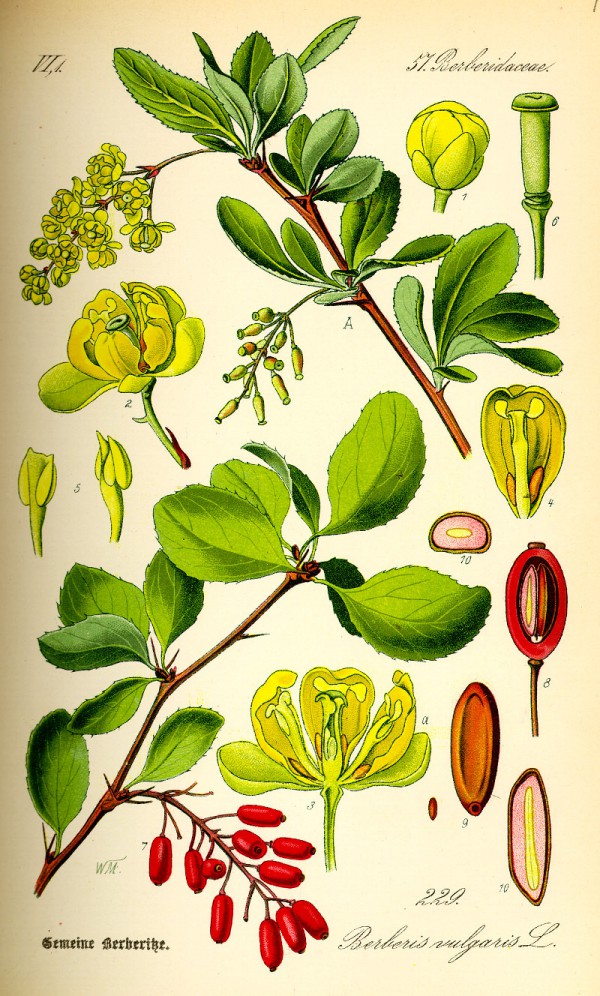Berberis vulgaris L. - Berberidaceae - barberry, European barberry, Berberitze, Sauerdorn
Small deciduous shrub, spiny, up to 2m tall, native to Europe, North Africa, West Asia, cultivated as ornamental or for fruit; leaves thick, obovate to oblanceolate or elliptic, serrate; flowers yellow; fruit ovoid to oblong, red or purple, juicy solid berry.
„In Europe, the berries have been traditionally used as an ingredient in making jam. The berries are high in pectin which makes the jam congeal as it cools after having been boiled. In southwestern Asia, especially Iran, the berries are used for cooking, as well as for jam-making. In Iran, barberries are commonly used as a currant in rice pilaf.“ http://en.wikipedia.org/wiki/Berberis_vulgaris
„Fungi, just as flowering plants, may use mimicry to steal resources to ensure survival. An impressive example is that of the witches brooms on Berberis vulgaris, which are induced by the systemically infecting rust fungus Puccinia arrhenatheri… During the spermatic stage of P. arrhenatheri, the infected leaves of B. vulgaris reveal a yellowish color, reminiscent of flower petals, and emit a strong floral-fruity and herbaceous scent, which is mainly due to indole, methyl nicotate, carvacryl methyl ether, (Z)-7-decen-5-olide, jasmine lactone, (Z)-7-decen-4-olide, γ-jasmolactone, and its precursor (E,Z)-5,7-decadien-4-olide….
Fungal infection inhibits the barberry shrub from blooming. The flowers of uninfected B.vulgaris open later in the season, when the fungus has terminated the production of spermatia. By contrast to the flowery-fruity fragrance of witches brooms, B. vulgaris flowers emit a peculiar spermy odor even though it is based on pleasant odorants such as linalool and isomers of lilac aldehyde and lilac alcohol. The spermy odor aspect frequently encountered in flower scents is due to minor amounts of 1-pyrroline and traces of 2-acetyl-1-pyrroline.“
[Flowers and fungi use scents to mimic each other., Kaiser, R., Science, 311(5762), 2006, 806-807]
„The barberry (Berberis vulgaris L.) fruits growing wild in Turkey were analyzed for some physical (dimensions, geometric mean diameter, sphericity, bulk density, fruit density, volume, terminal velocity, hardness and porosity) and chemical (moisture, reducing sugar, ascorbic acid, total anthocyanin and phenolics, crude protein, crude oil, crude energy, crude fiber, ash, pH, acidity, alcohol-soluble extract and color) properties…
The energy, reducing sugar, protein, cellulose, oil, ash, acidity, ascorbic acid, total phenolics, total anthocyanin and soluble solid matter values of barberry fruits were established as 69.25 kcal/g, 6.52%, 10.32%, 9.42%, 0.84%, 1.12%, 3.10%, 256.48 mg/kg, 789.32 mg/100 g, 931.05 mg/kg and 19.4%, respectively.“
[Some physicomechanical and nutritional properties of barberry (Berberis vulgaris L.) fruits., Akbulut, Mehmet, et al., Journal of food process engineering, Vol.32.4, 2009, 497-511]
Barberry fruits from Georgia contained sugar 4.9%, total acidity 7.1%, and pectin 0.4%.
[Minor and Underutilized Fruits in Georgia and Their Wild Relatives., Maghradze, D., Bobokashvili, Z., Kvaliashvili, V., In I International Symposium on Wild Relatives of Subtropical and Temperate Fruit and Nut Crops 948, 2011, 41-48]
Analysis of six purple-black barberry accessions from Turkey showed high values of total phenolic (16.2%) and total monomeric anthocyanin (14.8%). The major sugars of the fruits were glucose (8.8%) and fructose (6.1%) and dominant organic acids were malic (7.5%) and citric (1.3%).
[Antioxidant capacity and chemical properties of selected barberry (Berberis vulgaris L.) fruits., Özgen, M., Saraçoğlu, O., Geçer, E.N., Horticulture, Environment, and Biotechnology, Vol.53(6), 2012, 447-451]

Thomé, O.W., Flora von Deutschland Österreich und der Schweiz, Tafeln, vol.2, t.229 (1885)
http://plantgenera.org/species.php?id_species=138865
Berberis vulgaris fruiting
© Rolf Marschner (2007),
www.botanische-spaziergaenge.at